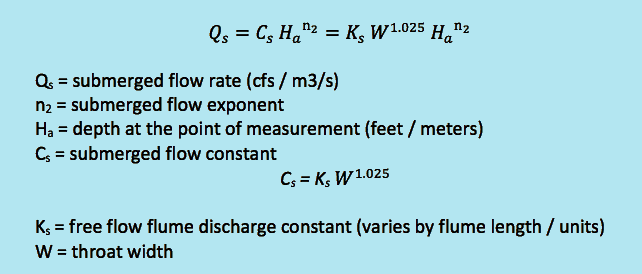This website uses a variety of cookies, which you consent to if you continue to use this site. You can read our Privacy Policy for
details about how these cookies are used, and to grant or withdraw your consent for certain types of cookies.
Filter By:
Submerged Flow
For optimal accuracy (and ease of flow measurement) a Cutthroat Flume should operate under free-flow conditions where discharge out of the flume is not restricted by downstream conditions. When downstream resistance to flow increases above a certain point and reduces the upstream velocity through the flume a backwater effect is created. This transitions from free, unrestricted flow, to one of backwater / slowed velocity is known as the submergence transition (St).
It is important to remember that although a flume installation may have originally designed for free-flow at an installation, changes in the downstream hydraulics can submerged the flume.
Designed to operate on flat gradients, smaller sizes of Cutthroat Flumes have somewhat greater resistance to the effects of submergence that the Parshall Flume.
The submergence transition – the point at which downstream hydraulics restricts flow out of the flume – increases as the flume length increases.
| 18-inch L Rectangular Cutthroat | 60% |
| 36-inch L Rectangular Cutthroat | 65% |
| 54-inch L Rectangular Cutthroat | 70% |
| 108-inch L Rectangular Cutthroat | 80% |
The submergence transition is taken as a ratio of the secondary point of measurement depth (Hb – located in the diverging section) to the depth at the primary point of measurement (Ha – located in the converging section).

| Length | Width | n2 | KS (Imperial) | KS (SI) | CS (Imperial) | CS (SI) |
|---|---|---|---|---|---|---|
| 18” | 1" | 1.741 | 3.250 | 3.983 | 0.261 | 0.0952 |
| 18” | 2" | 1.741 | 3.250 | 3.983 | 0.516 | 0.1882 |
| 18” | 4" | 1.741 | 3.250 | 3.983 | 1.408 | 0.3823 |
| 18” | 8" | 1.741 | 3.250 | 3.983 | 2.140 | 0.7806 |
| 36" | 2" | 1.480 | 2.580 | 2.1402 | 0.413 | 0.1040 |
| 36" | 4" | 1.480 | 2.580 | 2.1402 | 0.837 | 0.2108 |
| 36" | 8" | 1.480 | 2.580 | 2.1402 | 1.705 | 0.4294 |
| 36" | 16" | 1.480 | 2.580 | 2.1402 | 3.465 | 0.8727 |
| 54" | 3" | 1.410 | 2.250 | 1.6789 | 0.548 | 0.1200 |
| 54" | 6" | 1.410 | 2.250 | 1.6789 | 1.120 | 0.2453 |
| 54" | 12" | 1.410 | 2.250 | 1.6789 | 2.275 | 0.4983 |
| 54" | 24" | 1.410 | 2.250 | 1.6789 | 4.575 | 1.0021 |
| 108" | 12" | 1.390 | 1.700 | 1.0303 | 3.50 | 0.3049 |
| 108" | 24" | 1.390 | 1.700 | 1.0303 | 7.11 | 0.6196 |
| 108" | 48" | 1.390 | 1.700 | 1.0303 | 14.49 | 1.2591 |
| 108" | 72" | 1.390 | 1.700 | 1.0303 | 22.0 | 1.9148 |
The secondary point of measurement (Hb) is located in the discharge portion of the Cutthroat flume (as it has a zero length throat).
As the submergence in the flume increases, small measurement errors determining the level become critical. Submergence corrections are therefore capped at 95%, although the difficult of measuring Hb make a submergence ratio of 90% the upper end of correctable flow.
Turbulence at Hb typically makes determination of the head at this location difficult. To make the measurement of Hb easier, a stilling well is typically used. The stilling well helps to reduce surface turbulence and dampen sudden changes in water level so that more accurate measurements can be taken.
Keep in mind that stilling wells are not suitable for use on sanitary flows and may create a maintenance issue where sediments / solids are present as they may precipitate out of the flow and collect in the bottom of the stilling well (and potentially clog the intake port to it).
While Openchannelflow normally recommends that Cutthroat Flume installations be designed for free-flow, it's not to say that submerged flow installations are without benefits.
Installation / retrofit costs usually being less for submerged flow installations as there is no need to elevate the flume in the channel or to build up the upstream channel banks.

LOCATIONS IN ATLANTA, GA & BOISE, ID

